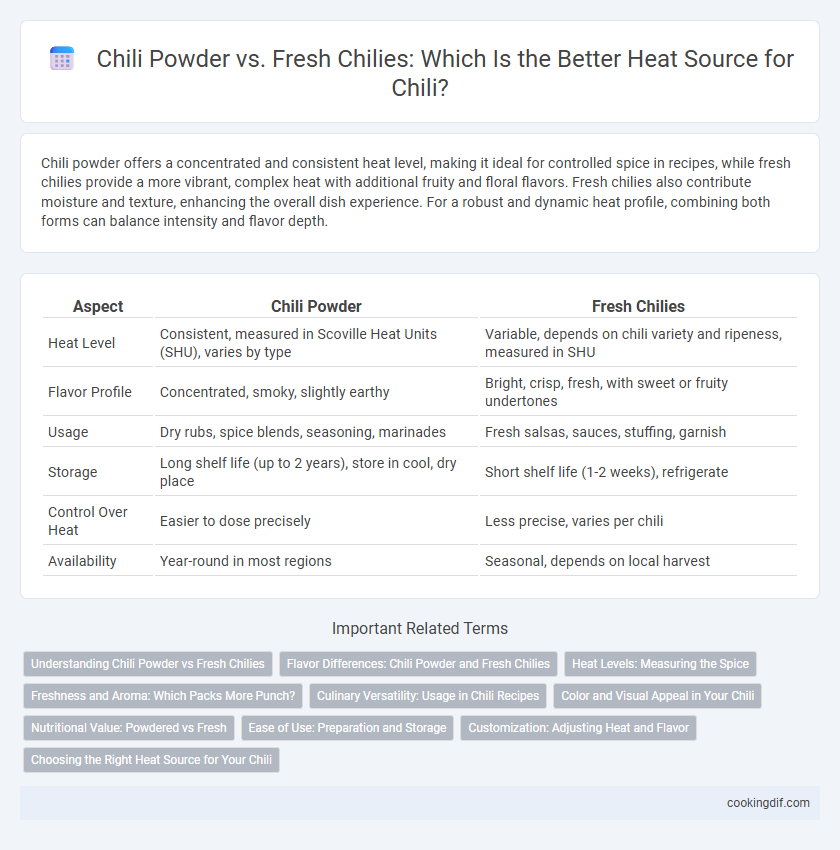Chili powder offers a concentrated and consistent heat level, making it ideal for controlled spice in recipes, while fresh chilies provide a more vibrant, complex heat with additional fruity and floral flavors. Fresh chilies also contribute moisture and texture, enhancing the overall dish experience. For a robust and dynamic heat profile, combining both forms can balance intensity and flavor depth.
Table of Comparison
| Aspect | Chili Powder | Fresh Chilies |
|---|---|---|
| Heat Level | Consistent, measured in Scoville Heat Units (SHU), varies by type | Variable, depends on chili variety and ripeness, measured in SHU |
| Flavor Profile | Concentrated, smoky, slightly earthy | Bright, crisp, fresh, with sweet or fruity undertones |
| Usage | Dry rubs, spice blends, seasoning, marinades | Fresh salsas, sauces, stuffing, garnish |
| Storage | Long shelf life (up to 2 years), store in cool, dry place | Short shelf life (1-2 weeks), refrigerate |
| Control Over Heat | Easier to dose precisely | Less precise, varies per chili |
| Availability | Year-round in most regions | Seasonal, depends on local harvest |
Understanding Chili Powder vs Fresh Chilies
Chili powder and fresh chilies differ significantly in heat intensity and flavor profile, with chili powder offering a more consistent and concentrated capsaicin content due to its dried and ground form. Fresh chilies provide a vibrant, immediate heat with distinct fruity or vegetal undertones, influenced by their variety and ripeness. Understanding these differences allows for precise heat control and flavor customization in culinary applications.
Flavor Differences: Chili Powder and Fresh Chilies
Chili powder offers a concentrated, smoky flavor profile with a consistent heat level due to the drying and grinding process, enhancing dishes with earthy undertones and mild bitterness. Fresh chilies deliver a vibrant, bright heat that varies based on ripeness and variety, contributing crisp, vegetal notes and a fresh aroma to recipes. The choice between chili powder and fresh chilies significantly impacts flavor complexity and heat intensity, influencing the overall sensory experience in culinary applications.
Heat Levels: Measuring the Spice
Chili powder typically offers a measured heat level based on the Scoville Heat Units (SHU) of its blended dried peppers, allowing for consistent spiciness in recipes. Fresh chilies, such as jalapenos, habaneros, or serranos, vary widely in heat depending on their variety and ripeness, ranging from 2,500 to over 350,000 SHU. Using chili powder provides controlled heat, while fresh chilies contribute dynamic, unpredictable spice intensity and freshness to dishes.
Freshness and Aroma: Which Packs More Punch?
Fresh chilies deliver a more vibrant aroma and sharper heat due to their essential oils and moisture content, which degrade quickly in dried chili powder. The volatile compounds responsible for the pungency and complex flavor of fresh chilies tend to diminish during the drying and grinding process required to make chili powder. For recipes that demand a pronounced, fresh chili kick, whole fresh chilies offer a more intense sensory impact compared to their powdered counterparts.
Culinary Versatility: Usage in Chili Recipes
Chili powder offers a consistent, controlled heat and deep, smoky flavor that blends seamlessly into chili recipes, enhancing complexity without overpowering other ingredients. Fresh chilies provide a vibrant, sharper heat and distinct aroma, allowing cooks to customize spice levels and add textural contrast to dishes. Using both ingredients in tandem optimizes the balance of flavor depth and fresh heat, elevating the overall culinary versatility of chili preparations.
Color and Visual Appeal in Your Chili
Chili powder offers a deep red hue that evenly infuses dishes with vibrant color, enhancing visual appeal in chili recipes. Fresh chilies provide varied shades of green, red, or yellow, adding dynamic color contrast and texture to the dish. Using chili powder ensures consistent heat and vibrant redness, while fresh chilies contribute brightness and a more natural, multi-dimensional look.
Nutritional Value: Powdered vs Fresh
Chili powder contains concentrated levels of vitamins A, C, and antioxidants due to the drying process, but it may lose some heat intensity compared to fresh chilies, which provide a higher moisture content and more vitamin C. Fresh chilies offer more capsaicin per serving, the compound responsible for heat and metabolic benefits, while powdered chili's heat can vary depending on processing and seed inclusion. Nutritionally, fresh chilies contribute more hydration and enzymatic activity, whereas chili powder offers convenience with a longer shelf life and consistent flavor profile.
Ease of Use: Preparation and Storage
Chili powder offers unmatched ease of use compared to fresh chilies due to its long shelf life and ready-to-use form, eliminating the need for chopping or deseeding. Fresh chilies require immediate preparation and careful handling to avoid irritation, and their perishable nature demands refrigeration to maintain quality. For convenient heat addition with minimal preparation and storage concerns, chili powder is the preferred choice in most kitchens.
Customization: Adjusting Heat and Flavor
Chili powder offers consistent heat levels and a blend of spices that can be precisely measured for recipe control, enabling easy customization of flavor intensity. Fresh chilies provide variable heat depending on type and ripeness, allowing cooks to finely tune the spiciness and add vibrant, fresh flavor nuances. Combining both gives chefs flexibility to achieve specific heat profiles and flavor complexity in dishes.
Choosing the Right Heat Source for Your Chili
Choosing the right heat source for your chili depends on the desired intensity and flavor complexity; fresh chilies offer a vibrant, sharp heat with fruity undertones that develop during cooking, while chili powder provides a more controlled, smoky warmth with consistent heat levels. Fresh chilies contain capsaicin concentrations that vary by variety and ripeness, influencing the final heat profile, whereas chili powder blends often include ground dried peppers, cumin, and other spices, enhancing depth without overpowering the dish. For recipes requiring precise heat control and a layered spice presence, chili powder is ideal, while fresh chilies excel in dishes where bold, fresh heat complements the texture and overall flavor.
Chili powder vs fresh chilies for heat source Infographic

 cookingdif.com
cookingdif.com